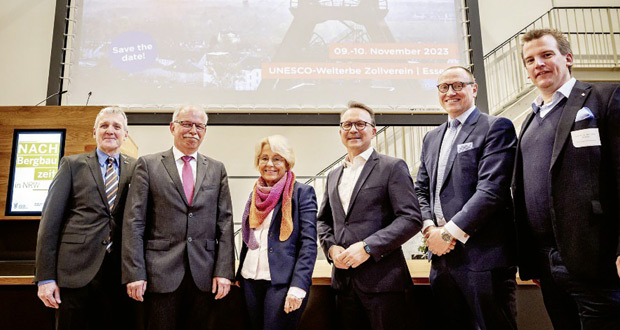North Rhine-Westphalia is a post-mining state: intensive raw material mining has left its mark especially in the Ruhr region and the Rhenish mining area. “When mining goes, what remains are challenges such as ground movements, large opencast mining lakes, disused sites of industrial culture or the so-called eternity tasks. At the same time, however, there are also many opportunities to reshape the region,” says Prof. Christian Melchers, head of the Research Center of Post-Mining (FZN) at TH Georg Agricola University (THGA), Bochum/Germany. How to deal responsibly with the legacy of mining was the focus of the specialist conference “NACHBergbauzeit in NRW” on 30th March 2023 at the THGA (Figure 1). Under the title “Geomonitoring – on water, on land and from the air”, around 300 experts came together in Bochum to exchange innovative methods.

Fig. 1. Jointly opening the post-mining era in NRW 2023 (from left to right): Prof. Peter Goerke-Mallet, Research Center of Post-Mining at the THGA, Andreas Welz, Head of Department 6 of the Arnsberg District Government, Bärbel Berger-hoff-Wodopia, Member of the Board of RAG-Stiftung, Ulrich Wessel, Managing Director of the university sponsoring company DMT-LB, Prof. Christian Melchers and Prof. Tobias Rudolph, Research Center of Post-Mining at the THGA. Photo: THGA/Holger Jacob
Because when it comes to monitoring mining impacts, a lot of high-tech comes into play: from deep-sea probes underground to special drones in the air to satellites that can make ground movements or changes in the water balance and vegetation visible. “In this way, we are also making an important contribution to better understanding climate change in detail and to sensibly designing the so-called “blue-green infrastructure” – with knowledge from post-mining,” says Prof. Melchers. In the lecture programme, the speakers addressed which monitoring methods are best suited and how they can be combined in a meaningful way.
Bärbel Bergerhoff-Wodopia, member of the board of the RAG-Stiftung and chairwoman of the THGA’s university council, addressed the students in the hall in particular in her welcoming speech: “I am particularly pleased about your participation in the conference. Your interest in the topic of post-mining is for us as the RAG-Stiftung, but also for me personally, an incentive and motivation for the many years of promotion and support of the THGA and the FZN. We will continue to need well-trained experts for the topics we are discussing at today’s conference. The fact that you have chosen to study engineering shows that you want to help shape a new, green future. When it comes to the sustainable use of geo-resources and water management in former mining regions, know-how from post-mining is immensely important and will also be in great demand in the future.”
“However, we do not only want to reach experts with our joint series of events. We have the declared goal of informing politicians, administrators and the public about issues related to post-mining in North Rhine-Westphalia and to actively involve them in ongoing discussion processes,” says Andreas Welz, Head of the Mining and Energy Department in NRW of the Arnsberg District Government, when welcoming the participants. As the competent mining authority, the Arnsberg district government is responsible for a large number of mining consequences and takes care of risk management in affected areas – in NRW alone, more than half of all municipalities have to deal with the legacy of mining.
Ralf Groß-Holtick from the city of Gronau presented a special municipal project in which many citizens were also involved: The city planning officer presented the results from the research cooperation “Monitoring Epe”, in which the FZN, the city of Gronau and the local citizens’ initiative, among others, have worked closely together over the past two years. Their common goal: the establishment of long-term and accurate monitoring in the geologically special region around Gronau.
“Salt has been mined here intensively for almost 50 years. In the process, large cavities, the so-called caverns, have been created underground,” explains Prof. Tobias Rudolph from FZN. In the meantime, natural gas, crude oil or helium is stored in most of them. Right next door is a moorland, the Amtsvenn. “This special location leads to ground movements and also repeatedly to tensions – not only in the geological structures themselves, but also between the residents, the city and the various operating companies.” The research cooperation has now provided more transparency between science and society and is to be continued in the coming years. An enduring challenge is the communication of scientific results. Especially in an environment that is often emotional due to personal involvement.
For the eighth time, the Arnsberg District Government, Department of Mining and Energy in NRW and the FZN of the THGA jointly organised the conference “NACHBergbauzeit in NRW”. The next event in the series will take place in March 2025. (THGA/Si.)
